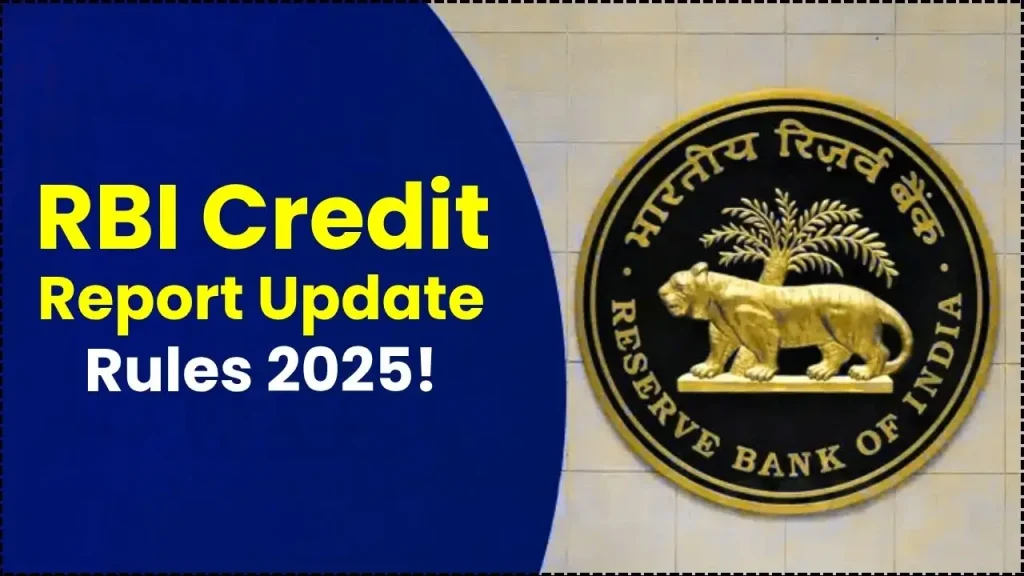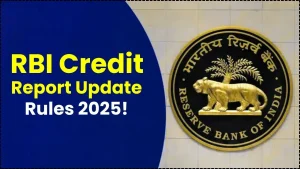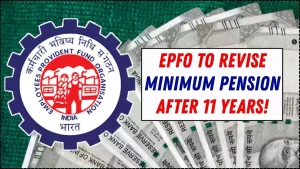If you’ve ever cleared a big credit card bill or closed a loan and then waited weeks for your score to budge, relief is here. The RBI introduces new 2025 guidelines to speed up credit report updates so borrowers no longer get penalized by outdated data sitting in their files. These rules push lenders and credit bureaus to operate on a predictable 15-day rhythm, dramatically cutting the lag between your action and what shows in your report.

RBI credit report update rules 2025 is the shift to twice-monthly reporting: lenders must compile borrower data “as of” the 15th and the last day of each month, submit within a tight, calendar-based window, and credit bureaus must process it quickly. In simple terms, your repayments, limit changes, closures, and lender-approved corrections will reflect sooner, supporting faster decisions when you apply for loans or credit cards.
New 2025 Guidelines to Speed Up Credit Report Updates
| Key Change | What It Means | Why It Matters |
|---|---|---|
| Fortnightly Reporting | Data is captured as of the 15th and the last calendar day each month; shorter intervals allowed by agreement | Your credit file reflects activity sooner, preventing outdated information from lingering |
| Lender Submission Window | Lenders submit each batch within a defined number of calendar days after the reporting date | Reduces data staleness and speeds up reflection of repayments and closures |
| Bureau Processing SLA | Credit bureaus must process lender files within a set number of days after receipt | Tighter turnaround leads to faster score updates and fewer underwriting delays |
| Continuity Mechanism | A mandated mechanism ensures reporting continues even if a bank/NBFC’s licence/CoR is cancelled | Protects borrowers from data freezes and incomplete credit histories |
| Oversight And Accountability | Bureaus must flag non-compliance and maintain reporting discipline | Improves data quality and protects consumers through routine supervision |
RBI credit report update rules 2025 are a genuine win for borrowers: predictable, twice-monthly updates; tighter lender submission windows; and faster bureau processing. Plan payments around the 15th and month-end, confirm your lender’s batch timing, and recheck reports shortly after each cycle. With the cadence now working in your favor, your responsible actions translate into faster eligibility improvements—and more confident applications when it counts.
What Changed and Why It Matters
- Faster visibility of your actions: Paying down utilization, regular on-time EMIs, or closing a facility will show up significantly faster than under the old monthly cycle. That means a better chance of securing approvals or improved terms when timing matters, such as before a home loan application.
- Predictable cadence for planning: With updates anchored to the 15th and month-end, you can schedule large repayments just before these dates to get improvements reflected in the next credit update window. This is especially useful when you want your report to show a lower balance or cleared account ahead of fresh applications.
- Standardization across lenders and bureaus: A single, unified framework reduces mismatches and delays that used to occur when different institutions followed different cadences. With uniform expectations, the whole ecosystem moves more consistently.
- Stronger consumer protection: The continuity mechanism ensures your data keeps updating even if a lender exits or loses licence, avoiding gaps in your credit history through no fault of your own.
What It Means for Borrowers Day-To-Day
- Score movement becomes timely: If you clear a high card balance or prepay a loan, the improvement should appear in your report within the next cycle instead of waiting an entire month or more.
- Disputes and corrections move faster: When a lender approves a correction—say, a wrongly reported late payment—bureaus are now expected to reflect that change within their tighter processing windows. This reduces the risk of an old error undermining your eligibility for new credit.
- Better underwriting outcomes: Lenders will see more current information, which typically means lower friction and fewer conditional approvals that hinge on legacy data. You’re less likely to be judged by outdated utilization or balances.
How Lenders and Bureaus Must Operate Now
- Lenders’ operational sprint: Regulated entities need robust internal workflows to finalize data as of the 15th and month-end, validate files quickly, and submit within the required window. This often means better data hygiene, reconciliations, and automation on their side.
- Bureaus’ service-level discipline: Credit bureaus must complete ingestion, validation, and publication of updated tradelines within short, calendar-based SLAs, raising the bar on their internal tooling, quality checks, and exception handling.
- Compliance, not best-effort: These timelines aren’t optional. The framework envisions oversight and consequences for non-compliance, aligning incentives across the ecosystem to prioritize speed and accuracy for consumers.
Effective Dates, Deadlines, And Practical Timing
- The new cadence is live for 2025: The 15th and last day are the anchor dates. Institutions are expected to meet the submission and processing SLAs aligned to those anchor points.
- Continuity by design: A dedicated reporting mechanism must be in place to continue credit updates even where a bank or NBFC’s licence/CoR is cancelled, with a firm deadline for implementing this safeguard.
- How to plan your moves: If you pay down a card on the 13th–14th or the 28th–30th, you boost the odds of that low utilization being captured in the very next “as of” snapshot, which then flows through lender submission and bureau processing shortly after.
RBI Credit Report Update Rules 2025 In Practice
RBI credit report update rules 2025 boils down to this: your credit file is fresher, and your efforts count faster. To leverage it, time your big repayments just before a reporting date, confirm with your lender when they will submit within the post-date window, and check your report after the bureau’s processing period. This ensures you’re always one cycle ahead when you need to apply.
Actionable Tips To Benefit Immediately
- Time payments smartly: Target the 15th and month-end. Clearing dues right before these dates helps your utilization and repayment status count toward the next update.
- Lock in zero balances before applications: If you plan to apply for a loan or card in the second half of the month, aim to have low utilization by the 13th–14th; for early-month applications, time it by the 28th–30th.
- Confirm closures and corrections: After closing a card or finishing a loan, ask your lender when the closure will be reported and request written confirmation. If you’ve won a dispute or correction, follow up on the batch date.
- Monitor all major bureaus: Pull your reports across all leading agencies to ensure the update is reflected uniformly. Minor sequencing differences can occur, so checking across bureaus keeps you informed.
- Automate good behavior: Set payment reminders and auto-debits to avoid accidental late fees and derogatories. Regular on-time payments now translate into quicker positive reinforcement in your file.
- Keep utilization low: Aim for under 30% utilization—and ideally under 10%—on revolving credit around the two reporting dates. This has an outsized impact on many scoring models.
Who This Helps The Most
- Home loan and auto loan aspirants: When debt-to-income ratios and utilization are tight, timely reflection of a cleared card can make or break approval, or shift you into a better rate bracket.
- Small business owners and professionals: If you rely on personal credit for working capital or business cards, a faster cadence lets you capitalize on recent clean-up moves to unlock higher limits or better products.
- Consumers fixing legacy errors: If your file carried a disputed late or an outdated closure, the new SLAs help you lock in a faster correction so you can move ahead with pending applications.
Context: Why Now
- Digital lending scaled up the need: Instant underwriting and pre-approved offers only work when back-end data is fresh. Monthly cycles created blind spots, leading to friction and occasional unfair outcomes.
- System-wide risk management: Fortnightly reporting reduces the gap where new borrowings or stress don’t appear yet, helping lenders assess affordability and curb overleveraging.
- Global alignment: Moving toward more frequent, standards-based reporting brings India closer to best practices in modern credit markets.
Common Misconceptions, Clarified
- “My score will update daily now.” Not exactly. The cadence is twice per month, with specific anchor dates plus defined submission and processing SLAs. You’ll see quicker updates, but not real-time daily changes.
- “One bureau updated, all will be instant.” Each bureau has its own processing workflow. Check all major bureaus after each cycle to confirm alignment; slight timing differences can occur.
- “I paid yesterday, why isn’t it visible?” The update reflects snapshots as of the 15th and month-end. If you paid just after an as-of date, your change will typically show in the following update window.
Practical Timeline Example
- You clear a large card bill on the 13th.
- The next “as of” date is the 15th, so your low balance is captured in that snapshot.
- Your lender submits data within the required calendar-day window after the 15th.
- The bureau processes within its SLA after receipt.
- You check your reports a short while later and see utilization drop and score improve ahead of your planned application.
Consumer Checklist For 2025
- Set reminders: Schedule calendar alerts for the 12th–14th and 27th–30th to nudge yourself to review balances and payments.
- Track closures: Keep closure letters or emails for loans/cards and note the batch date for reporting.
- Pull multi-bureau reports: After each cycle, review reports for consistency and raise disputes promptly if mismatches appear.
- Keep documentation: Store statements, payment proofs, and dispute acknowledgments. If a lender misses a window, your documentation speeds escalation.
- Apply strategically: If you’re on the cusp of a better rate slab or limit, wait for the next update window to reflect your latest improvements.
FAQs on New 2025 Guidelines to Speed Up Credit Report Updates
How often will my credit report update now?
Twice a month. Data is captured “as of” the 15th and the last day of each month, followed by lender submission and bureau processing windows that make updates visible faster.
When should I pay my credit card for the biggest score impact?
Pay before the 15th and again before month-end if needed. Keeping utilization low on those dates maximizes the chance your next update reflects a favorable balance.
Do all bureaus show changes at the same time?
They follow the same cadence and SLAs, but visible timing can vary slightly. Always check across bureaus after each cycle.
What if my lender’s licence gets cancelled will my data freeze?
No. A continuity mechanism is mandated so your data continues to update even if a bank/NBFC’s licence or CoR is cancelled.
















